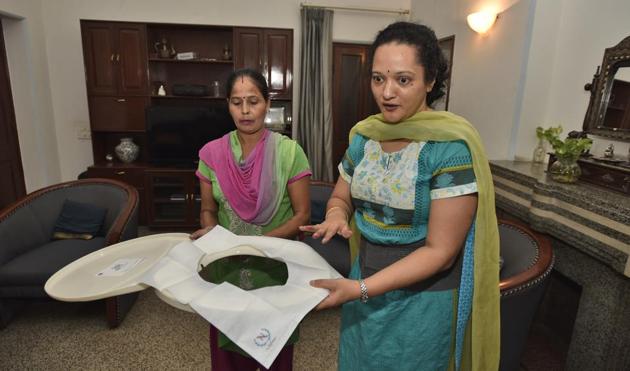Thinking out of the bowl: The movement for germ-free public toilet seats
A Delhi homemaker has invented a toilet seat cover you can slip into your bag and carry around with you. IIT students are innovating with a pedal device...
“Feels like silk, shields like steel,” declares 52-year-old Neena Narayan, laughing at her sexy tagline for a decidedly unsexy product: toilet seat covers. The slogan (it makes her teenage sons cringe, she says) sums up the pack of five disposable, waterproof seat covers that she calls ‘Sit Free’.

How do Indians, especially women and the elderly, pee safely in a public toilet? That was the question that struck Narayan, a homemaker, one morning in 2015 while she waited for an appointment at her doctor’s clinic. She was consumed enough by the thought that she spent the next year-and-a-half in pursuit of the perfect toilet seat cover.
That goal — a germ-free toilet seat — puts her among a rare breed of innovators.
The site of mankind’s most indispensable act hasn’t progressed much in the last hundred years. The flush toilet has changed little since it was first invented in 1596; and then popularised in the mid-to-late 19th century. Before that, in the words of one chronicler, toilets were a “collection of communal outhouses, chamber pots and holes in the ground”.
Much of the last century’s “toilet innovation” has been restricted to design and aesthetics: toilet bowls have morphed into several shapes, sported creative looks and even sparked patriotic angst when Chinese travellers couldn’t resist warm Japanese toilet seats, tense foreign relations be damned.
In Japan, the mother of toilet innovation, chamber pots also come fitted with aquariums, or piped music.
In the plushest of toilets, seat covers are automatically replaced, triggered by motion sensors or the flush mechanism. But Narayan was looking for a cheaper option: what if you can “carry your care?”

After numerous conversations with fabric suppliers, she ended up with a toilet seat cover that was papery and soft on top, waterproofed with plastic on the bottom. Each one comes with a foldable flap into which you can slide your hands, preventing any contact with the toilet seat while you fit the cover onto it or dispose of it after use.
Narayan’s isn’t the only recent innovation to tackle the problem of the dirty toilet seat. Five engineering students at IIT-Madras have built a mechanical device that can be attached to a toilet and, upon pedalling, sanitises the seat and wipes until it’s dry. They estimate each unit will cost about Rs 500.
Such initiatives offer a cheap and convenient defence against urinary tract infections, which are especially common among women in India.
The mechanical device is a modular design that fits all toilets, says Tanay Garg, one of the students who built it. But they are working to mechanise the process further so it would work without pedalling. “We are not sure how many people will follow the instructions” says Garg.
Also, the device needs to be installed in public loos by whoever is constructing or running them.
Sit Free, which Narayan hopes to sell for Rs 99 a pack, is a simpler option because the packs can be sold at railways stations and airports or even dispensed inside public toilets. But both hope to clean up toilets and make them more usable.
But, some would argue, a dirty toilet seat is a secondary problem in a country where 600 million people have no access to toilets and those public loos that do exist are plagued by lack of water, electricity or maintenance.
“They are engineers, so they engineer things,” says S Vishwanath, who teaches about water at the Azim Premji University in Bangalore, referring to the mechanical pedal. “But that doesn’t tackle the root of India’s sanitary woes. It is not a question of technology as much as it is a question of ownership. A community needs to be invested in keeping a toilet up and running.”
Get Current Updates on India News, Lok Sabha election 2024 live, Election 2024 along with Latest News and Top Headlines from India and around the world.




